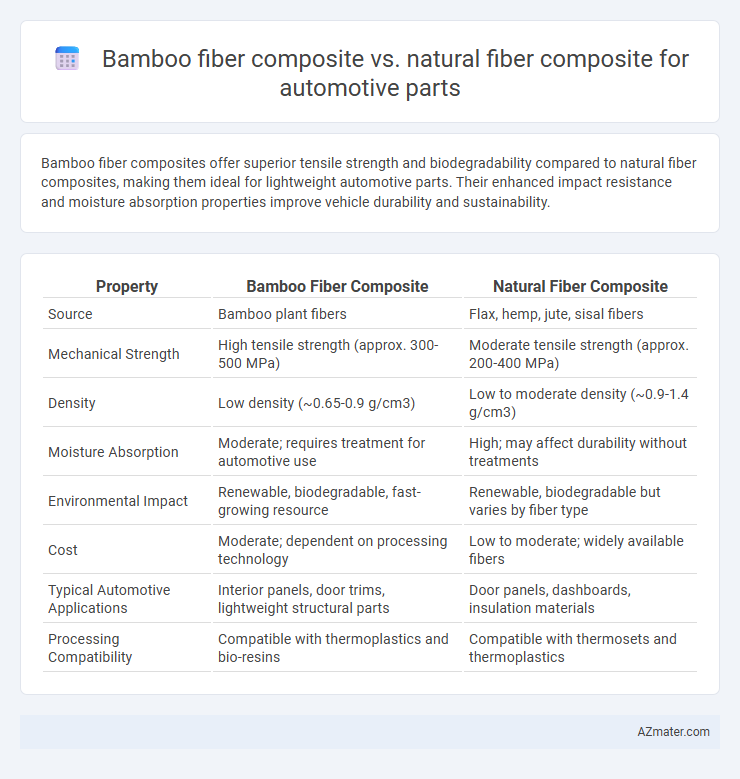Bamboo fiber composites offer superior tensile strength and biodegradability compared to natural fiber composites, making them ideal for lightweight automotive parts. Their enhanced impact resistance and moisture absorption properties improve vehicle durability and sustainability.
Table of Comparison
| Property | Bamboo Fiber Composite | Natural Fiber Composite |
|---|---|---|
| Source | Bamboo plant fibers | Flax, hemp, jute, sisal fibers |
| Mechanical Strength | High tensile strength (approx. 300-500 MPa) | Moderate tensile strength (approx. 200-400 MPa) |
| Density | Low density (~0.65-0.9 g/cm3) | Low to moderate density (~0.9-1.4 g/cm3) |
| Moisture Absorption | Moderate; requires treatment for automotive use | High; may affect durability without treatments |
| Environmental Impact | Renewable, biodegradable, fast-growing resource | Renewable, biodegradable but varies by fiber type |
| Cost | Moderate; dependent on processing technology | Low to moderate; widely available fibers |
| Typical Automotive Applications | Interior panels, door trims, lightweight structural parts | Door panels, dashboards, insulation materials |
| Processing Compatibility | Compatible with thermoplastics and bio-resins | Compatible with thermosets and thermoplastics |
Introduction to Automotive Fiber Composites
Automotive fiber composites enhance vehicle performance by combining fibers with resin matrices to achieve lightweight, high-strength materials. Bamboo fiber composites offer superior tensile strength, biodegradability, and vibration damping compared to conventional natural fibers like jute or flax. These materials provide sustainable alternatives in automotive parts, reducing overall vehicle weight and improving fuel efficiency without compromising structural integrity.
Overview of Bamboo Fiber Composites
Bamboo fiber composites offer significant advantages in automotive applications due to their lightweight, high tensile strength, and excellent biodegradability compared to traditional natural fiber composites like jute or flax. These composites provide superior impact resistance and vibration damping, which enhance vehicle safety and comfort while reducing overall weight for improved fuel efficiency. The renewable nature and rapid growth rate of bamboo make it an eco-friendly alternative, aligning with sustainability goals in modern automotive manufacturing.
Overview of Natural Fiber Composites
Natural fiber composites, used in automotive parts, combine renewable fibers such as hemp, flax, jute, and kenaf with polymer matrices to deliver lightweight, sustainable alternatives to traditional materials. These composites offer enhanced vibration damping, reduced weight, and improved environmental impact through biodegradability and lower carbon emissions during production. The high tensile strength and stiffness-to-weight ratio of natural fiber composites create efficient structural components, making them suitable for interior panels, door trims, and dashboards in automotive applications.
Material Properties: Bamboo Fiber vs Other Natural Fibers
Bamboo fiber composites exhibit superior tensile strength and impact resistance compared to many other natural fiber composites such as flax or hemp, making them ideal for automotive parts requiring durability and lightweight performance. The high cellulose content and unique microstructure of bamboo fibers enhance stiffness and dimensional stability, promoting better mechanical properties under dynamic loads. Bamboo fibers also provide improved moisture resistance and biodegradability, offering an eco-friendly alternative without compromising material integrity in automotive applications.
Manufacturing Processes and Techniques
Bamboo fiber composites use hand lay-up, compression molding, and resin transfer molding techniques tailored to their cellulosic structure, ensuring enhanced fiber-matrix adhesion and reduced moisture absorption. Natural fiber composites, including flax and hemp, often require chemical treatments like alkali or silane to improve interfacial bonding during injection molding or compression molding processes. Advanced manufacturing strategies for both composites focus on optimizing fiber orientation and impregnation to meet automotive industry standards for strength, lightweight, and sustainability.
Mechanical Performance Comparison
Bamboo fiber composites exhibit higher tensile strength and impact resistance compared to many natural fiber composites such as flax or hemp, making them suitable for automotive parts requiring durability. The high cellulose content and unique microstructure of bamboo provide enhanced stiffness and fatigue resistance, critical for load-bearing components. Natural fiber composites generally offer better vibration damping and reduced weight but often fall short in mechanical robustness relative to bamboo fiber composites in structural applications.
Sustainability and Environmental Impact
Bamboo fiber composites offer significant sustainability advantages over traditional natural fiber composites due to bamboo's rapid growth rate and high carbon sequestration capacity, reducing overall environmental impact and resource depletion. Natural fiber composites, commonly derived from crops like flax and hemp, provide biodegradability and lower energy consumption in production but often require more intensive agricultural inputs, affecting water use and soil health. The automotive industry benefits from bamboo fiber composites by achieving lightweight, durable parts with reduced carbon footprints, aligning with global efforts to minimize vehicle emissions and promote eco-friendly manufacturing practices.
Cost Analysis and Market Viability
Bamboo fiber composite offers lower raw material costs and faster renewability compared to natural fiber composites like flax or hemp, making it a cost-effective option for automotive parts. Market viability of bamboo composites is enhanced by their lightweight and strength-to-weight ratio, which reduces vehicle fuel consumption and emissions, aligning with automotive industry sustainability targets. However, limited processing infrastructure for bamboo fibers poses challenges in scaling production compared to more established natural fiber composites with existing supply chains.
Challenges and Limitations in Automotive Applications
Bamboo fiber composites face challenges in automotive applications due to inconsistent fiber quality, limited thermal stability, and difficulty in achieving uniform dispersion within polymer matrices, impacting mechanical performance and durability. Natural fiber composites, while eco-friendly, exhibit moisture absorption leading to swelling and reduced interfacial bonding, which compromises dimensional stability and long-term reliability in automotive parts. Both materials require advanced processing techniques and surface treatments to overcome these limitations and meet stringent automotive industry standards for safety and durability.
Future Trends and Innovations in Fiber Composites
Bamboo fiber composites are gaining traction in automotive manufacturing due to their superior strength-to-weight ratio and sustainability compared to traditional natural fiber composites like hemp or flax. Innovations in fiber treatment and hybridization with bio-resins are enhancing bamboo composites' mechanical properties and durability, making them viable for structural parts. Future trends emphasize integrating smart sensors within bamboo composites for real-time performance monitoring and developing fully biodegradable automotive components to meet stringent environmental regulations.

Infographic: Bamboo fiber composite vs Natural fiber composite for Automotive part
 azmater.com
azmater.com